Redistricting Commission Reaffirms Legislature Expansion, giving the likely final say
by Robert Lynch; August 26, 2022
It may not please some incumbents, the Tompkins County Legislature’s longest-serving member in particular. But the citizen commission empowered to redraw County legislative district lines once a decade reaffirmed Wednesday its previous call for the Legislature to grow larger than it’s ever been before. Membership would rise from 14 to 16 legislators beginning in an election that won’t take place until 2025.
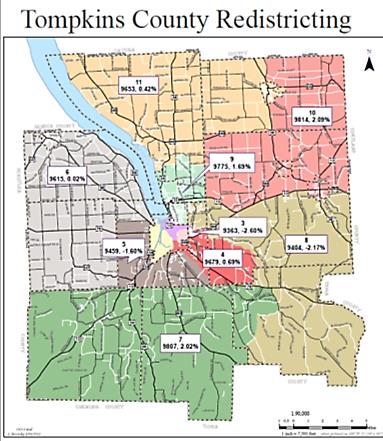
And there’s likely nothing County lawmakers, themselves, can do to stop it.
The 16-member proposal is “by far, the best for me,” said Vivek Iyer, one of nine who sit on the Tompkins County Independent Redistricting Commission (TCIRC), an advisory group mandated under the County Charter to draw district lines once every ten years. “The other alternatives have their own sets of problems,” Iyer said.
Under the County Charter, barring some sort of undisclosed legal challenge, the Legislature may have little choice but to accept the Commission’s August 24th recommendation.
At the urging of Dryden’s Mike Lane, chief critic of the 16-member plan, the County Legislature voted narrowly August 2nd to exercise the Charter’s only remaining option and send the initial proposal back to the Commission for a second look. The Commission undertook that revisit Wednesday and considered four alternate redistricting maps, one of which would have cut legislative size to as few as 11 representatives. The more than 90-minute session ended with the TCIRC, without dissent, reaffirming the original recommendation it first handed up back in late-April.
Most expected the Commission to reaffirm its 16-member proposal. In meetings since mid-December, the Commission had reviewed numerous, repeatedly-revised alternatives for adjustment of legislative size and district boundaries to satisfy both the federal demands for population parity mandated a half-century ago by the Supreme Court, and also recently-adopted New York State standards set twice as rigid as what the U.S. Constitution requires following every decennial U.S. Census.
Under the new State rules, district populations, largest to smallest, may differ by no more than five per cent. The Supreme Court allows up to a ten per cent deviation.
“I don’t think we can overemphasize what a game-changer the reduction of the ten per cent to the five per cent rule was,” Tompkins County Attorney Bill Troy told the Commission Wednesday. “It just changed everything…. And not only did it change everything, it did so on short notice.”
Lane wrote the Resolution and led the legislative drive to remand the 16-member proposal back to the TCIRC. The Dryden Democrat urged the Commission to revise its proposal and consider shrinking the Legislature’s proposed size and making membership an odd number so as to avoid inconclusive tie votes.
Dutifully, County staff produced alternative options the Commission considered Wednesday. Two of the choices would have set membership at 15; another at 13; and still another at only 11 legislators, the minimum number the Charter allows. Commission members favored none of the new options.
“The districts are just too big,” remarked Commission member Marcia Lynch (this writer’s sister), joining others who quickly dispatched the 11-member scheme to the trashcan. “Unless we had some kind of a mandate or direction that we needed to reduce the size of the Legislature significantly,” Lynch remarked regarding the 11-member proposal, “I don’t see any need to move forward with this.”
The maps’ draftsperson, County Information Technology Director Greg Potter, pointed out that by cutting the headcount from 16 legislators to just 11, each member would represent far more people, that number growing from 6,500 to 9,700.
The change would also place communities far apart in distance and far afield in character under the representation of just one person.
“That one’s a hum-dinger,” Commission member Margaret Hobby observed, and not approvingly, of a meandering Ithaca-Dryden-Caroline district created under the 11-member plan. “I was just amused that it puts Northeast Elementary School (Town of Ithaca) and Speedsville (at the Tioga County line) in the same district.” Laughter followed.
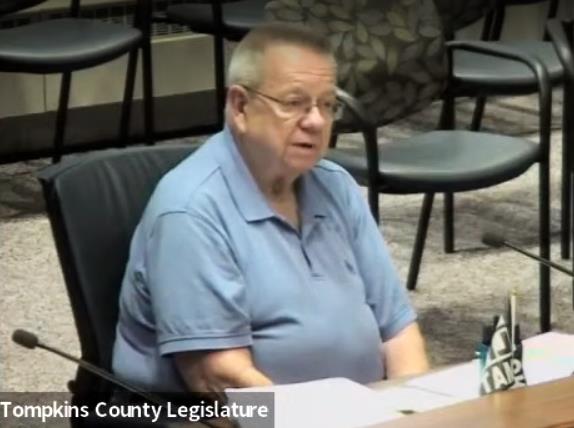
Nevertheless, on Cayuga Lake’s west side, either the 11-member or 13-member plans would have made far less mischief. In either instance, the plans, if adopted, would have placed the Town of Enfield under a single representative, folding it into the Ulysses district currently represented by Democrat Anne Koreman.
But in so doing, either plan would also have removed Enfield’s other current legislator, Randy Brown, from the town entirely. The 11-member design would have retained Brown’s representation of Newfield, but would also have stretched his district east through all of Danby and into Caroline. With 13 legislators, Brown would have represented all of Newfield, much of Danby, plus the Town of Ithaca’s southwestern corner.
The 11-member plan would likely have set up a future Election Day face-off between Republican Brown and Danby Democrat Dan Klein, both incumbents. Across the county, the 11-member design could have prompted a Republican Primary battle between Lansing’s Mike Sigler and Groton’s Lee Shurtleff.
Under one of two, 15-member alternatives, also disfavored by the Commission Wednesday, the southern third of Enfield would have been removed from Brown’s Newfield-centered district and merged, instead, with Amanda Champion’s Town of Ithaca home turf. The second, 15-member design would have retained Brown’s representation of southern Enfield.
Throughout the redistricting process, City of Ithaca leaders have asked that County legislative lines be kept conterminous with those of Ithaca’s five wards. Some of IT Director Potter’s new designs fulfilled that request better than did others.
Adding to the concerns of Mike Lane were those of African-American City legislator Travis Brooks, who urged the Commission take its second-look on grounds that his minority-heavy urban district had been fractured and diluted under what the Commission had first proposed. Brooks expressed concern about his proposed district’s “geographical size” and its “footprint.”
You’re “carving out the middle of the flats,” Brooks complained of his newly-proposed district, including “the heart of the Northside,” he said. Brooks maintained that the current plan leaves “just one representative for the majority of low-income housing.”

Later in the meeting, however, Brooks’ message got muddled as he at times suggested that minorities might actually benefit from representation by multiple legislators, and not just one.
“I like my odds better when I have two or three people possibly advocating for me, said Brooks. “So, I get it in theory. But in practice, we have one vote. But only one person represents all of our own voices, and I don’t think that’s fair.”
Answering Mike Lane’s second concern, the Redistricting Commission’s Chair Wednesday downplayed any problems an even-numbered Legislature might impose.
“While frustrating, those problems are not fatal to the work of the County Legislature,” Chair Hank Dullea concluded. Mike Lane, present at Wednesday’s meeting, would disagree.
Lane refreshed Commission members’ memories about the two-month long, multi-ballot, seven-seven voting deadlocks that occurred in early 2020 when the County Legislature tried and tried again to elect its leader.
“It went on for a long time,” Lane told the Commission. “It ended up with the County Clerk making a decision on who would be the Chair of the Legislature.”
Lane continued, “In the meantime, the Temporary Chair (Republican Sigler) assumed that he was the actual Chair and began—had to be stopped from appointing committees and other things that the chairmanship required…. It was troublesome.”
The core problem with divided votes, Lane insisted, is deadlock. “Neither side gets to have its position move forward,” he said.
****
But the Redistricting Commission’s original, 16-legislator plan will, indeed, move forward, likely to receive final adoption by the Legislature at some unspecified date. Unlike in some other jurisdictions, the Tompkins County Charter provides the Legislature no clear path to overrule the Commission once the TCIRC has reaffirmed its initial proposal. The Legislature has already held a public hearing on the original 16-member plan. No one complained.
Yet, the Legislature faces no great urgency to take a vote. The revision would not alter district lines or member composition until January 2026. That’s when the lawmaking body’s next election cycle takes effect.
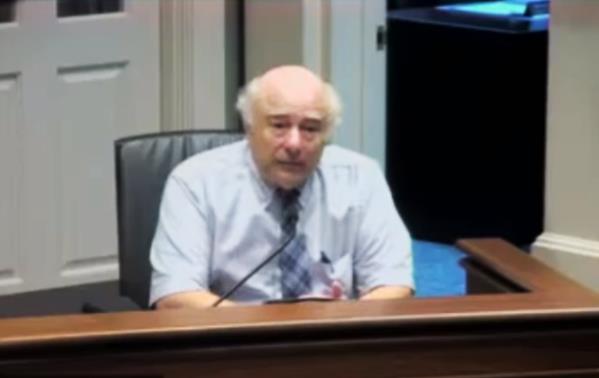
Dryden’s Lane voiced disappointment Wednesday about the implementation delay. In June 2020, the Legislature had rejected—yes, by a 7-7 vote—Lane’s effort to shorten what are now lawmakers’ current terms to enable a reapportioned County Legislature to take office sooner.
“We have people who are underrepresented until 2026,” Lane complained to the Commission. “That’s not equal protection. That’s not what our Constitution talks about.”
In his remarks that began Wednesday’s meeting, Lane also alluded to possibly reviving the back-up plan he’d suggested two years ago, namely calling upon the Legislature—and then, the voters—to approve temporary weighted voting to even the representational imbalance. County lawmakers briefly tried weighted voting decades ago. They didn’t like it. And their successors never attempted it again.
###
The Election Aftermath:
Enfield winners Riley, Webb, Clinch Dem’s nomination
Della Pia rolls up landslide local win, yet still falls short
By Robert Lynch, Updated August 24, 2022 @ 7:38 PM

By landslide margins in Enfield and throughout Tompkins County, Congressional candidate Josh Riley and State Senate hopeful Lea Webb bolted to the lead and won their respective Democratic nominations for Congress and the New York State Senate Tuesday. Meanwhile in the Special Election to fill the final months of Congressman Tom Reed’s term—an election in which all voters could participate—Democrat Max Della Pia rolled up an incredible lead in both Enfield and Tompkins County. But Della Pia’s local advantage failed to surmount Republican majorities elsewhere in the 23rd Congressional District, giving the GOP’s Joe Sempolinski the districtwide win.
Unofficial, though largely-complete, tabulations from across the new 19th Congressional District, released by the New York State Board of Elections Wednesday, gave Endicott native Riley the party nomination over the Hudson Valley’s Jamie Cheney by a more than 20 percentage point margin. District-wide, Riley garnered 30,462 votes (61.5%) compared to Cheney’s 17,474 (35.3%).
“I am so honored to be the Democratic nominee for Congress here in New York’s 19th District,” Riley said in a brief victory statement given to news organizations the night of his win.
“I am so proud of the campaign we ran and want to thank our volunteers and grassroots supporters from the bottom of my heart,” Cheney responded, conceding defeat and reflecting upon a congressional race that some had expected would be closer than it actually was.
State Board of Elections figures show Riley having won majorities in each of the 11 counties of his 19th District, winning with majorities ranging from 53.5% (Sullivan County) to 79.5% (Cortland County).
Tompkins County’s results, expanded to include both early voting and absentee ballots received and counted by Primary day, show Riley winning Tompkins County 6,609 votes (68.3%) compared to Cheney’s 3,044 votes (31.5%).
Enfield tallies in the Congressional race, similarly updated, show Riley continuing to carry Enfield by a two-to-one margin; the revised totals, 180 votes (66.2%) for Riley, 92 votes (33.8%) for Cheney.
In the race for New York State Senate, former Binghamton Councilperson Lea Webb jumped out to an early lead in the redrawn 52nd Senate District and rode that lead to victory over Ithaca’s Leslie Danks Burke.

Districtwide, the State-released figures for the three-county 52nd Senatorial District, show Webb with 10,976 votes (58.8%) and Danks Burke with 6.953 votes (37.3%). Webb secured majorities in Tompkins, Cortland and Broome Counties. Her victory margin in Tompkins County was actually the smallest of the three.
In Tompkins County, updated unofficial totals give Webb 5,692 votes (57.4%) over Danks Burke’s 4,208 votes (42.5%).
Webb also led in Enfield with revised totals of 156 votes (56.1%) for Webb, compared to 122 votes (43.9%) for Danks Burke.
“This campaign was never about me, alone. It was always about building a platform for those voices who have gone neglected and unheard for so long,” Webb said in a victory statement Tuesday night. “The stakes have never been higher, extremism continues to persist. But I am confident we will ride this people-powered wave to victory in November.”
Meanwhile, in the Special Election to fill the remaining four months of Congressman Tom Reed’s term in the “old” 23rd Congressional District, had Democrat Max Della Pia pulled off a surprising upset win—which he did not—he would have had blue-leaning Tompkins County, including Enfield, to thank.

The “lame-duck 23rd,” the district from which Tompkins County will be cut free from at year’s end, leans heavily Republican. And in every county but Tompkins, Republican Joe Sempolinski won majorities to succeed for a mere four months the already-resigned Tom Reed. Sempolinski won the night, but Democrat Della Pia put up a tough fight, running neck and neck with Sempolinski at times. And Della Pia’s lead among Democrat-dominant Tompkins County’s voters wasn’t even close. He won more than five votes out of every six.
Revised, State-released tallies show Della Pia in Tompkins County with 11,287 votes (85.1%) compared to Sempolinski’s mere 1,951 votes (14.7%)
Sadly, for Della Pia, the Tompkins County margin was nowhere near replicated district-wide. The 11-county District total showed Republican Sempolinski winning overall with 52.8% of the vote, compared to Della Pia’s 46.4%.
In Enfield, machine totals from election night showed Della Pia securing 277 votes (72.1%) to Sempolinski’s 106 votes (27.6%).
Republicans had no contests Tuesday for either the 19th District Congressional nomination or the local race for State Senate. Marc Molinaro—who lost a Special Election in an adjacent district Tuesday similar to the NY-23 seat Sempolinski won—will face Josh Riley in the fall. Former Binghamton mayor Rich David will face Lea Webb in the State Senate race. Neither Molinaro nor David was opposed for his party’s nomination; thus there was no Primary.
****
Looking toward November, Josh Riley Tuesday took little time to celebrate. Instead, he made it clear he remains in full campaign mode.
“For too long,” said Riley in his brief victory statement, “Upstate New Yorkers have been sold out by professional politicians and special interests. I’m running for Congress to bring change and new leadership.”

Riley continued, “This is a campaign by working families, for working families, committed to bringing the high-tech jobs of the future to Upstate New York.”
As for Max Della Pia, he, too, remains in the hunt. Though he lost the Special Election Tuesday, he’ll remain the Democratic nominee to fight to represent the redrawn 23rd Congressional District next year. In November, Della Pia will face Republican Nick Langworthy, who won the Republican nomination in the 23rd District Tuesday, thereby ending a bruising Primary fight against Buffalo businessman Carl Paladino.
Because of redistricting, Tompkins County, though it took part in the Special Election, will only get to watch November’s Della Pia-Langworthy contest from the sidelines. Tompkins will have to resolve the Riley-Molinaro contest instead.
###
City Attorney takes “adversarial” stand in County-run ethics probe
by Robert Lynch; August 19, 2022
The Ithaca City Attorney’s first reply to an ethics panel’s investigation into City Hall’s alleged mishandling of the Reimagining Public Safety effort did not rest well with some panel members Friday. And what portions were made public of Ari Lavine’s response at the Tompkins County Ethics Advisory Board’s meeting suggested that the City wants to limit the Board’s scope as much as it can.
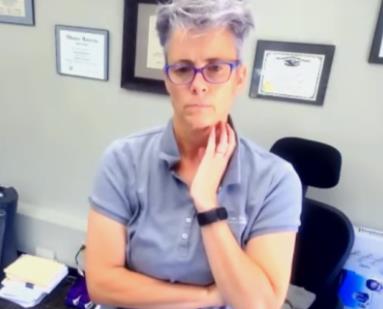
“I’m sort of out of the loop when it comes to politics,” Ethics Board member Sharon Sulimowicz admitted to her fellow members, after reading Lavine’s reply. “But it sounded like it was very adversarial, and I’m kind of wonderin’ why?”
“I guess I share your assessment,” Advisory Board Chair Rich John answered. “And I don’t understand that either.”
Lavine’s reply to the Ethics Advisory Board, a message received only one day before Friday’s meeting, provided only a partial answer to what the Board had requested from City Hall back in June. Lavine said he needed until month’s end to supply a “narrative” to accompany the documents he submitted the Board Thursday.
But as described by Chair Rich John, Lavine’s transmittal letter—not yet released to the public—“raised certain objections” to the scope of the Board’s probe. Purportedly, Lavine imposed lawyer-client objections to some of the questions asked. And the City Attorney also, according to the Advisory Board’s Chair, insisted that the panel has “no authority to inquire on certain elements of the ethics complaint we received.”
In April, Ithaca Alderperson Cynthia Brock alerted County Attorney Bill Troy to potential ethics violations relating to the City’s efforts to rebuild its policing structure under the broader City-County “Reimagining Public Safety” collaborative. At the core of Brock’s complaint is her allegation that former Ithaca Mayor Svante Myrick inappropriately allocated City or third-party funds to retain two civilian consultants in the restructuring effort, Karen Yearwood and Eric Rosario. Since the Alderperson’s initial complaint, Brock has broadened her request to include other aspects of the Reimagining process.
Since the City of Ithaca has no ethics commission of its own, Brock’s concerns got handed to the County’s legally-required advisory board by default.
In June, the Board sought information from former Mayor Myrick, current Acting Mayor Laura Lewis, Rosario, Yearwood, and others at City Hall, as well as from Tompkins County’s former Administrator, Jason Molino. To date, some have responded; others have not.
City Attorney Lavine’s letter, written on behalf of Mayor Lewis, Chief of Staff Faith Vavra, Alderperson Robert Cantelmo, and himself, drew jurisdictional boundary lines that some on the Ethics Board found unsettling.
“I found it to be lawyerly,” remarked Board member Brian Eden.
“This does fit the tenor of what a typical litigation response is,” Rich John agreed. “I didn’t think this was a fully flushed out response.” And certainly the conclusions that we have no authority to ask questions, except for very, very limited aspects of the… city working group’s members being paid by a third party, I’m not sure I agree with it.”
What’s more, John, an attorney and Tompkins County legislator, questioned Lavine’s contention that certain conversations Lavine has had with City personnel were guarded by attorney-client privilege.
“The attorney-client privilege for municipal attorneys is not the same as that for attorneys in private litigation,” John informed the Board. “The public has certain rights to know.”
That right to know will soon prompt disclosure of Lavine’s reply and those from other so-called “interested parties.” The Ethics Advisory Board informally agreed Friday to release responses publicly at some point after the August 31st deadline that Lavine had requested for his narrative’s submission.
Former Mayor Myrick has likewise asked until month’s end to “compile a comprehensive response.”
Myrick, who resigned as Mayor in February to become executive director of the advocacy group, People for the American Away, wrote the Board that he’s currently “crisscrossing the country for various candidates,” and would be hard to reach.
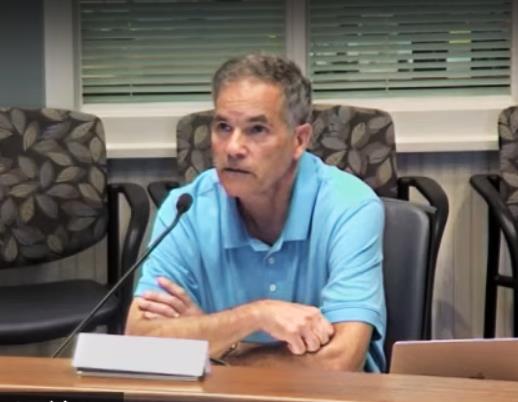
John reported Friday that neither Karen Yearwood nor Eric Rosario has replied so far to the Ethics Board’s inquiry; nor has the Center for Policing Equity, a police-critical advocate that both the City and County had retained to help in its joint Reimagining effort, but have since cast aside.
At its previous July 29th meeting, John disclosed that former County Administrator Molino had declined to respond to the Ethics Board questions, citing a “conflict of interest” that puzzled some Board members.
As the Ethics Board ended its 30-minute discussion Friday, it consented to withhold release of comments received until after the end-of-August deadline the City has requested. Once all comments come in, the Board will meet September 12th to review responses, likely “deliberate” on them in closed session thereafter, and then, in Rich John’s words, hold a “public meeting where we indicate next steps.”
“It would be better if we had everything in the open,” Sulimowicz said. People should know what was asked and what was answered, she added, “because obviously people are paying attention to this.”
“I would like to be as public as possible,” said Rich John, agreeing with Sulimowicz,. That way, he said, “the public can judge whether we’re doing our job and how we’re doing it.”
Publicly undisclosed though they are, the responses, for the diligent truth-seeker, may already be available through FOIL.
###
TCAT Board approves cuts; Enfield Sunday service ended
by Robert Lynch, August 17, 2022
Effective this weekend, TCAT buses will no longer serve the Town of Enfield on Sundays.
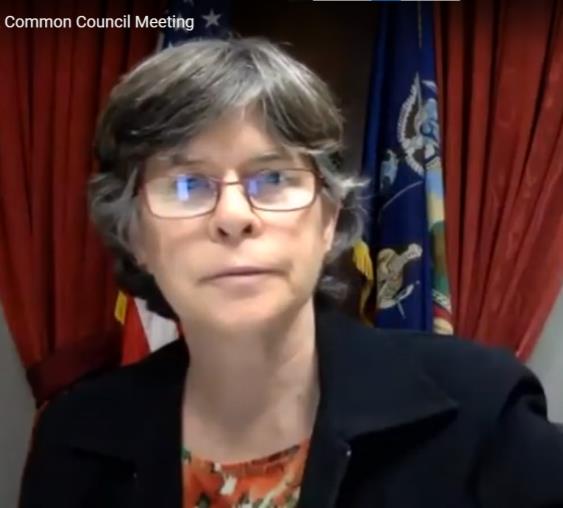
In a once-postponed, always-somber, 15-minute meeting Wednesday, the governing Board of Tompkins Consolidated Area Transit (TCAT) pulled the plug on Sunday service to Enfield as it approved a multi-route reduction plan that board members said was forced upon them by the twin problems of persistent labor shortages and the inability to procure bus parts.
“It pains all of us,” remarked TCAT Board member Jennifer Dotson, commenting at a meeting that at times sounded more like a funeral service. “But if the scheduled buses do not appear,” Dotson warned, “it’s worse.”
The cuts are “regrettable to make, yet necessary,” Ithaca Acting Mayor and TCAT Board member Laura Lewis said at the Wednesday meeting’s start. Lewis took note that the cuts, which may impact Enfield the hardest, are technically ‘temporary,” and could change if conditions improve. Yet few expect circumstances will improve or that schedules will adjust before the service’s fall season comes to an end during the dead of winter.
The service reductions will affect Enfield in two principal ways. Most importantly, effective August 21st, Sunday service will terminate. Secondly, TCAT will eliminate the midday run that would otherwise leave the Green Street bus stop at 10 A.M. and depart Enfield at 10:28.
In recent months, including during the summer, TCAT’s Route 20 has operated six weekday round trips to Enfield, plus three each on Saturday and Sunday. The changes the Board approved Wednesday would cut weekday round trips to five and eliminate Sunday runs altogether.
The TCAT Board had originally planned to enact the changes at a meeting Monday. Yet a flood of public comments at a public hearing then prompted board members to delay a decision for two days, in part to permit them to mull over their choices.
According to media reports, many of the comments Monday concerned not specific routes, but rather the working conditions for TCAT’s drivers.
Wednesday’s meeting, though, was not a hearing. No public comments were invited or given. Officials did confirm that by the meeting’s start, TCAT had received as many as 54 written comments concerning its plans.
A TCAT news release counted more than 40 participants at Monday’s public hearing.
Though the service’s planned reductions will impact nearly all of TCAT’s routes to varying degrees, cutbacks on four of those routes—including Route 20 to Enfield—became serious enough to trigger a mandated public hearing. Rules require a hearing whenever a route’s service shrinks by at least 20 per cent.
In addition to Enfield’s route, the reductions drawn to hearing were Route 82, affecting the Cornell campus; Route 11 to Ithaca College and South Hill; and Route 13 to Ithaca’s Fall Creek.
The only one of those routes to draw Board member comment Wednesday was the Cornell campus run. Board member Bridgette Brady, relaying rider concerns, questioned whether the frequency of Route 82’s runs could be restored during “peak times in the morning” to accommodate the needs of graduate students at the Maplewood Apartments.
TCAT’s Erik Amos told Brady said he saw no way to do that.
“If we get more operators in coming months, we can increase during peak times,” Mike Smith, Assistant General Manager for Operations and Maintenance, said regarding the Route 82 issue.
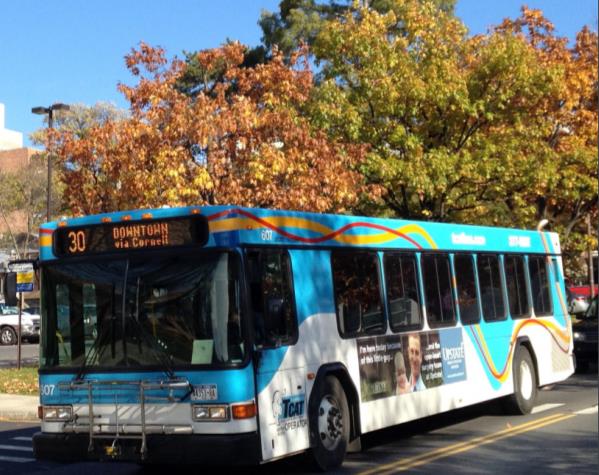
“TCAT and the entire transit industry are grappling with unprecedented worker shortages and are making the painful decisions in order to sustain and maintain reliability with the service we can provide,” TCAT General Manager Scot Vanderpool reiterated in a bus service news release following Monday’s hearing.
“We apologize to our riders and promise that, while we await supply chains to return to normal, we are not letting up on recruitment efforts that we began ramping up several months ago,” Vanderpool added.
“This is not something we relish doing,” Acting Mayor Lewis said as she prepared to cast her vote Wednesday in favor of the cutbacks. Lewis was one of the seven Board members voting and making the decision unanimous.
Frank Proto, a former County legislator, voted his support only “reluctantly.”
“I don’t envy your task at all,” Proto said to TCAT’s administrators.
###
About-Face: Baker Building to meet wrecking ball
by Robert Lynch, August 16, 2022
“Why cannot governments keep roofs on buildings?” this writer emailed Tompkins County Legislator Mike Lane after the meeting. “Someone should ask that question.” But sadly, Tuesday night, nobody did.
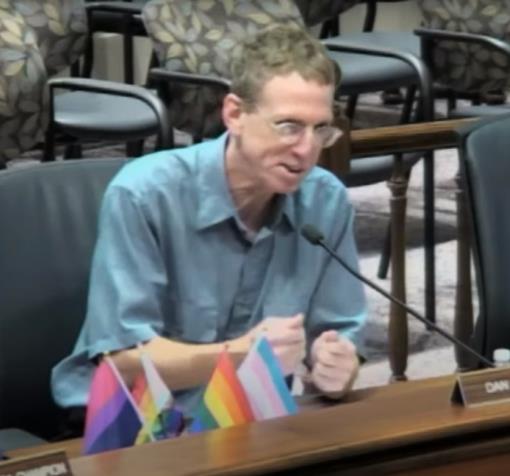
In a reversal of its decision of just two weeks earlier, the Tompkins County Legislature voted Tuesday to “deconstruct”—effectively, demolish—the former Baker Dental Office Building on the 400 Block of North Tioga Street. Only Legislator Lane voted against razing the structure. Though he’d spoken out against demolition at several prior meetings, Lane did not restate or provide fresh reasons Tuesday for opting to spare the orphaned, two-story structure.
Yet Dan Klein, supporter of the earlier, August 2nd Resolution to delay deconstruction, eagerly explained his change of heart.
“I made the case,” said Klein, recalling his earlier initiative, “that the building was maybe an old, wrinkled tube of toothpaste, but there was still some toothpaste in there and we could squeeze some life out of that thing.”
“But I was wrong,” said Klein. “I apologize for leading us down that false alley.”
What made the difference, for both Klein and others, was rain, rain pouring through a leaky roof.
Just before Tuesday’s meeting, Klein had alluded to pictures, or maybe even a video, of the structural shower bath. But the pictures never got shown. Nobody, except Lane, needed convincing. The Legislature reversed its early-August vote in only a matter of minutes.
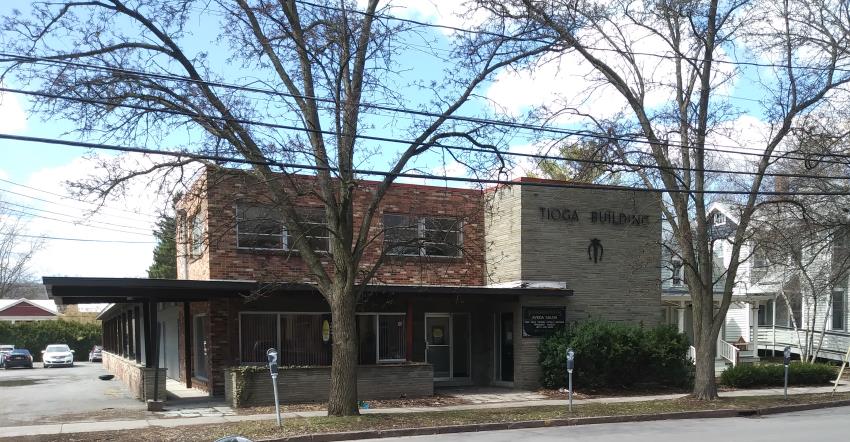
Klein had previously pushed for postponing demolition. He’d have granted the building just a two-month reprieve. The Danby lawmaker had won delay August 2nd by the narrowest of margins. Klein had suggested that non-profit agencies might need short-term space, and they’d find the Baker Building a useful temporary home until such time as the County determines what to do with it. Delayed demolition would give them time to express interest, he’d argued.
But “the building is further deteriorated than I was leading everyone to believe,” Klein admitted Tuesday. “We would need to put a roof on that thing immediately, at a cost of almost a Million dollars, before we even knew what we’re doing with it.”
No one challenged what might have been an inflated cost estimate. Quite obviously, aside from Lane, no one else remained interested in the 60’s-era medical building. County Facilities Director Arel LeMaro had made clear he’d tear the building down. LeMaro has said it would take as much as $2.36 Million to renovate the Baker Building for County offices. Deconstruction will only cost $150,000.
The County bought the Baker Building in 2019, expecting at that time to remove it and use the larger lot on which it sits for a new Center of Government. But later, the County purchased a new, more desirable lot for that Center closer to the Courthouse. Lawmakers have yet to decide what to do with the earlier real estate, which cost taxpayers $1.8 Million.
Once the Baker Building comes down, probably before winter, the County has only plans to pave it over for parking.
But leaky roofs and building demolitions at County-owned properties have a way of following one after another. It was arguably a neglected roof that led to the offloading and then the razing of the Old County Library a few years ago. And only when casting his vote two weeks ago on Klein’s earlier motion did Lane call the Old Library’s sale “one of the biggest mistakes this Legislature has made.”
****
The Legislature began its Tuesday meeting with public disinterest and apathy on full display. Since last December, in repeated meetings, the County’s Independent Redistricting Commission has labored to reapportion the County Legislature so that its 14 current districts match their populations to the 2020 U.S. Census. The Commission’s plan, which would expand the Legislature to 16 members, finally reached a Public Hearing Tuesday. But only this writer, representing the Enfield Town Board, offered any comment.
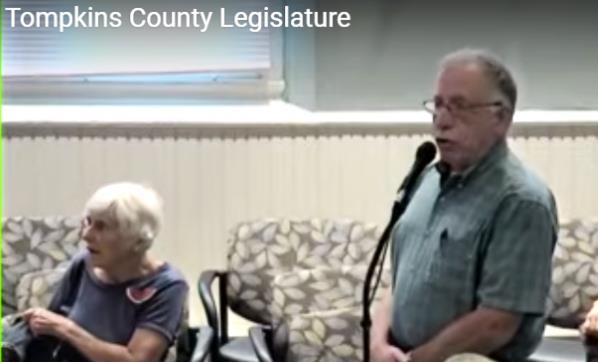
“The way this Redistricting Commission worked in dividing the Town of Enfield between two—and no more than two—legislative districts, we can be satisfied with,” this Councilperson, Robert Lynch, told the hearing. The Enfield representative declined comment on the plan’s more controversial issue of expanded membership, an issue to be resolved in future meetings.
“The Redistricting Commission did a heck of a job; they did a thorough job,” this lone speaker told Tuesday’s hearing.
The County Legislature took no action on the redistricting plan after hearing the Councilperson’s comment. Members had previously resolved to summon the Redistricting Commission into one further session to reconsider whether it should revise its plan to keep legislative membership smaller, and also to return it to an odd number. The Commission tentatively plans to meet August 24th.
###
Enfield gives Hochul a “nudge” on Firefighters Law; puts final touches on salt shed
by Robert Lynch, August 11, 2022
When it comes to the Town of Enfield’s granting its firefighters and EMS personnel a tax break that could help recruit and retain volunteers, consider the Town rounding third base and heading toward home. But it hasn’t quite yet scored that home run.

By a unanimous vote on a resolution cobbled together only 24 hours before meeting time and based on suddenly-learned new information, the Enfield Town Board Wednesday urged Governor Kathy Hochul to sign into law a bill approved by both the State Senate and Assembly, a bill that would allow municipalities statewide the option to grant up to a ten per cent reduction in property tax assessments for fire and EMS company volunteers.
We should give the Governor a “nudge,” Enfield Councilperson Robert Lynch (this writer) chief sponsor of the Enfield assessment reduction initiative, told Town Board members at their Wednesday monthly meeting.
Since late March, Enfield officials have advanced an initiative, modeled after one approved and implemented in Monroe County, that would enable Tompkins County, as well as its towns, villages and school districts, the option to grant through local law, a maximum ten per cent reduction in home property assessments to those fire and EMS company volunteers in their community who met certain service commitments. The Town Board passed a Resolution in April encouraging the County Legislature to request enabling “Home Rule” legislation from the State and thus replicate the Monroe County provisions locally.
But to underscore the distance and information gap between Enfield and Albany, Enfield officials did not learn until Tuesday that New York lawmakers had already gone one step better. With little fanfare, the State Legislature had adopted a measure that would extend statewide the local benefit Enfield had requested.
But though approved unanimously May 24th in the State Assembly and then June 1st in the Senate, the firefighter-friendly measure has yet to be signed by the Governor. Hochul holds the option to approve or veto the measure. Her schedule for addressing this end-of-session bill—one of many which generally get acted upon gradually over weeks to allow maximum media exposure—remains unknown.
Wednesday’s Town Board “nudge” marked the latest of several efforts Enfield has taken since early-spring to promote the volunteer recruitment incentive. Both Lynch and Town Supervisor Stephanie Redmond, who each serve as Town Board liaisons to the Enfield Volunteer Company (EVFC), have supported the initiative. In quarterly meetings, EVFC officials have stressed to Redmond and Lynch that the EVFC’s prime difficulty lies in recruiting and retaining volunteers for both its fire service, and most particularly, for the Enfield’s rescue squad.
A disproportionate number of EVFC monthly calls relate to medical emergencies. But whereas up to a dozen EMT’s had volunteered for the Enfield Fire Company some two decades ago, Chief Greg Stevenson reported last November that EMT ranks have thinned to as few as four currently. And one of those four, Stevenson then said, is inactive.
Enfield rescue squad EMT’s and lesser-trained Emergency Medical Responders are often the first to arrive at the location of a person in medical distress. They stabilize the patient and administer life-saving first aid until an ambulance arrives from Ithaca.

“I think that’s a small price to pay,” Lynch told the County Legislature April 5th, regarding the assessment reduction, “for the benefits that you derive by having a better, well-staffed volunteer fire service in this community.”
The state legislation, at least for the moment, circumvents Tompkins County’s need to appeal to the State for a Home Rule Law. If the pending bill secures Hochul’s signature, each taxing authority—including the Enfield Town Board and the County Legislature—would then need to draft and pass local laws to implement the assessment reduction.
“The Enfield Town Board supports Assembly Bill A10155-A, and Senate Bill S.9131, and urges this adopted legislation be signed into law,” the Town Board’s Wednesday action stated, its endorsement directed to both Governor Hochul and key New York lawmakers who steered the legislation toward approval.
State Senators Tom O’Mara and Pam Helming, both of whom represent portions of Tompkins County, co-sponsored the Senate version of the legislation.
As adopted and forwarded to the Governor, the exemption bill would apply only to the property assessments of those living within the territory of the volunteer company they serve; reduce the assessment only to a volunteer’s primary residence; require localities to determine criteria for longevity of service; and allow lifetime exemptions for those with more than 20 years of active service in a volunteer company.
****.
With construction largely complete, the Enfield Board Wednesday authorized the last expected major expenditures on the Town’s $750,000, grant-assisted salt and sand storage facility, located adjacent to the Town’s Highway Garage. But in doing so, the Board also pushed the project’s cost slightly above the sum it chose to bond for the project last spring.

Relying on a Tompkins County contract and thereby precluding the need to put the contract to bid, the Board selected Seneca Stone Corporation to pave the salt barn’s floor for an estimated $53,942. Shisler Electric will install lighting and related electrical apparatus for just under $14,000.
Highway Superintendent Barry (Buddy) Rollins cautioned that the paving cost could rise or fall slightly as the contractor reserves the right to adjust its rate based on the fluctuation of asphalt prices.
Supervisor Stephanie Redmond confirmed for Board members this week that the two latest contracts for necessary finishing work will push total cost to approximately $15,000 over the $750,000 the Board authorized in bonding last April. Redmond indicated the Town’s bookkeeper will recommend at a later meeting how to cover the overage. Redmond expects the moneys will come from accumulated fund balances.
Councilperson Lynch disclosed the $15,000 cost overrun to the public Wednesday, saying the Board needs to be transparent. Lynch pointed the blame squarely at persistent inflation. But he also mentioned that he has not heard even a single complaint from the public about the project or its need.
In other Town Board business Wednesday:
- The Board continued its discussions, at times, testy, over the need for some sort of heightened land use controls in the Town. Supervisor Redmond maintained that the Town’s Planning Board has requested Town Board guidance as to what kind of new controls it wants. But the Supervisor made clear she is not necessarily recommending Enfield enact a zoning law. The discussion ended with Redmond concluding planners should first focus on potential controls to manage what she defined as “landfills,” “noxious industries,” and “large commercial developments.”
Beyond those three, the Supervisor also voiced concerns about the proliferation of too many solar farms, and also the arrival of multi-unit or upscale housing developments. “I don’t want to encourage gentrification,” Redmond said. [Expect more to be written on this discussion in a later story.]
- Deputy Supervisor Isabel Castillo and Cornell Planning Dept. Intern Xigan Zhang shared with the Board a PowerPoint presentation for possible development of a town park, one likely to be located on Town-owned property near the Highway Department. Among their initial recommendations, the two suggested formation of a Park Committee to guide further planning efforts. The Board authorized a Town website-posted invitation for committee membership. Councilperson Cassandra Hinkle expressed interest in becoming the Town’s representative.
- And at the meeting’s start, both Councilpersons James Ricks and Lynch, in their separate remarks, expressed concern about recent acts of property destruction at Cayuga Indian Nation properties in Seneca County. [See separate posting on this website.] Tompkins County legislator Anne Koreman, also in attendance, revealed that she and unnamed other County legislators are working “behind the scenes” to draft a statement or Resolution to also address the Cayuga Nation incidents.
###
Enfield Board, Planners leery of zoning, despite development concerns
By Robert Lynch, August 5, 2022
Enfield Supervisor Stephanie Redmond stated it categorically to her Town’s Planning Board Wednesday night: “Nobody on the Town Board is ready to say let’s do zoning now. We’re not ready for a zoning commission.”

That commission, if Enfield were ever to appoint one, would take the first step toward the Town’s writing, and then adopting, its first-ever zoning ordinance. It could be divisive move. It could split constituent opinion down the middle. Redmond’s statement at the Planning Board session—and at a couple of Town Board meetings earlier this summer—has made it clear she realizes the risk. Other Town Board and Planning Board members realize it as well.
But how, then, does Enfield confront present and future development pressures, even hypothetical bogeymen, unwanted activities whose proponents could invite themselves in, unimpeded to an unprotected Enfield? That’s the concern of Supervisor Redmond and Councilperson Jude Lemke, Enfield’s combined driving force behind some form of modest land use regulation.
Enfield’s “long been the ‘sacrifice zone’ for Tompkins County,” Redmond told the Planning Board August 3rd. “Do we want every field covered in solar? We’re not saying we’re wanting zoning. It’s just an educational thing.”
Educational, perhaps, but also controlling. Zoning’s the quintessential rural libertarian’s denotation of “Big Government.” A zoning ordinance can tell you what you can build and what you can do, and where you can do it. More importantly, it can tell you what and where you cannot.
Planning Board member Mike Carpenter has had recent dealings with zoning officials in Ulysses. “They didn’t want anything to happen in the Town that didn’t increase their property values,” Carpenter told his Board, based on his own experience.
Enfield’s zoning talk first emerged at a Planning Board meeting in early June when Supervisor Redmond, out of the blue, brought the topic up.
“I do believe it is something we should consider,” Redmond told planners about potential zoning that June night.
But the Supervisor’s updated comment at the planners’ most recent meeting indicates she’s backtracked a bit.
In both June and July, Redmond placed discussion of potential zoning on the Town Board’s monthly agenda. It’s again up for discussion August 10th. In zoning’s two prior airings, the topic played to mixed reviews, raising tensions briefly at the Town Board’s meeting July 13th.
Redmond asked Board members for direction and a “list of concerns” they’d like potential new land use controls to address.
“Well, I’ll give you direction right now,” Councilperson Robert Lynch, (this writer), quickly and bluntly responded. “Let’s not go there.”
Lynch challenged Redmond’s assertion that citizen contributors to Enfield’s latest 2020-adopted Comprehensive Plan had frequently suggested and supported zoning, albeit anonymously. Lynch said that when he was on the campaign trail, he’d heard only one constituent endorse zoning controls.
At the July Town Board meeting and again before the Planning Board this month, Planning Board Chair Dan Walker clarified that Enfield’s current Comprehensive Plan does not recommend zoning.
****
Yet a single, overriding fear transparently dominates Redmond’s desire for zoning-style regulation. It’s a hypothetical risk that no one’s even predicted may happen, let alone proposed.
The Supervisor worries that the giant Seneca Meadows landfill near Waterloo—Mount Trashmore, as its detractors call it—might relocate to Enfield once it ceases operation up north within a few years.

“I would not like to see a landfill anywhere in our town,” the Supervisor emphatically told her Town Board July 13th. “The one up at Seneca Meadows is noxious; fumes for miles around; it smells terrible.”
Redmond repeated her concerns before the Planning Board last Wednesday. And two mornings after the Town Board met, Councilperson Lynch weighed in, via an internal email, saying that he, too, would not welcome the stinky giant.
“And to make my point clear,” Lynch wrote, “I do not want a ‘Seneca Meadows’ style dump in Enfield any more than our Supervisor does. I get sick to my stomach every time I travel north of Waterloo and Seneca Falls.… We once banned fracking. Could we also ban large landfills? For now, I’ll leave it there.”
“I don’t understand what they’re looking for from the Planning Board,” its member Mike Carpenter asked at Wednesday’s meeting, as planners began their attempt to answer the Supervisor’s laundry list of concerns.
As Redmond recited them, in addition to the landfill, threats loom like the number of solar farms, large housing developments, potential impact on Enfield’s aquifer and “noxious industry.”
“That sounds like a job for me,” Carpenter answered. He said he’d need both legal advice and “a good three months of Planning Board meetings” to tackle them all.
But whatever they address, and however they address them, planners made clear that night that the messaging demands nuance.
“We should avoid the Z-word,” Planning Board member Henry Hansteen said. No one disagreed.
“The public needs to know you don’t plan to have zoning,” Ann Chaffee chimed in. The plain-spoken, farmer Chaffee reminded Redmond that past controversies have produced “pretty heated discussions” at Town Board meetings. They’ve “brought anger and almost fist fights,” Chaffee recalled.
If Enfield is to have zoning, Carpenter said, the Town should “keep it from being too onerous.”
A good zoning law, Carpenter added “should get the things we do want and not get the things we don’t want,”
“Maybe we should identify things we do want and invite them in,” Chaffee suggested. Carpenter mentioned light industry, light commercial activity and single-family housing as possible welcome candidates.
Planning Board member Hansteen expressed disappointment when Codes Officer Alan Teeter informed him that a zoning law could not rid the town of tumbled-down dwellings. The property notice code cites dangerous buildings, Teeter said. And it only empowers the Codes Officer to order the structures secured.
And as for Redmond’s feared hypothetical Seneca Meadows-2, Planning Board Chair Dan Walker expressed doubts the dump would ever move to Enfield.
A large landfill, Walker said, typically requires 200-300 acres. Landfills in Enfield, he added, are “not conducive because of the hills.” A landfill was considered decades ago north of Bostwick Road, he remembered. But it never got built likely because of the limitations.
Then, again, Walker conceded, the project had been targeted for Enfield “because we didn’t have any regulations.”
“I don’t think we need a zoning ordinance to protect the Town from certain activities we don’t want,” Walker said. Yet he also reminded planners that if County or State authorities want to put a landfill in his town, they could always exercise eminent domain (and likely also pre-empt local laws) to do so.
As to a fracking-style targeted ban that Councilperson Lynch had suggested, Walker questioned such a law’s legality. Similarly, lawyer-Councilperson Lemke, at the Town Board’s meeting in July, doubted an outright ban would pass constitutional muster. Why a ban worked with fracking, no one has yet explained.
Of course, there’s another strategy. Planning Board member Chaffee suggested just planting one’s feet.
Chaffee said she knew someone—maybe it was herself—who owns those several hundred acres of needed land. That owner says, “It’ll be a cold day in Hell when you put a landfill in,” Chaffee predicted.
###
Legislature delays Baker Building razing; seeks use offers
by Robert Lynch, August 3, 2022
“Once it’s gone it’s gone.”

Tompkins County Legislator Dan Klein made that observation as a resolution presented the Legislature Tuesday night would have authorized immediate “deconstruction”—that’s demolition with salvaging reusable stuff first—of the Former Baker Dental Building, the two story North Tioga Street structure Tompkins County bought three years ago as part of a larger lot on which it then planned to build a new office building.
Plans changed. The County bought new, pricier land nearer the Courthouse. Now the half-century old brick and block Dental Building stands vacant. Its roof leaks. It leaks badly. Some lawmakers want to tear it down now and get their problems behind them. But at Dan Klein’s urging, the Legislature Tuesday chose to wait; delaying deconstruction for just two months to determine whether anyone can put the building to further, short-term use.
“I’ve been thinking about the Old Library,” Klein said. “I know that there were people who voted to sell that property who later regretted that vote.” Had the County retained the Old Library’s ownership, the decision “might have changed the whole conversation that we’re having right now about the future of the Center of Government,” the Danby lawmaker observed.
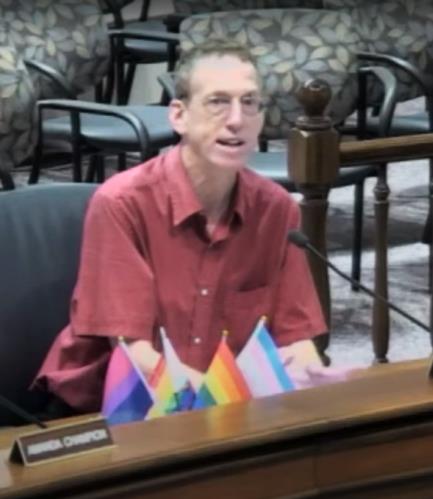
Indeed, it might have. And it’s easy for this writer to say, “See, I told you so.” I founded a whole political campaign last year on my insistence that the County’s sale of the Old Library at Court and North Cayuga Streets was a wasteful mistake. Maybe my campaign didn’t fare so well. But, for that matter, neither did the Old Library.
In 2017, Tompkins County sold the Old Library to housing developer Travis-Hyde Properties for a mere $925,000, little more than the assessed value of the land on which it sat. Travis-Hyde razed the still-serviceable—but also leaking—1960’s-era building. Only now, years later, is the developer finally beginning to construct “Library Place,” an upscale senior citizens apartment project, upon the site.
Meanwhile, Tompkins County, which offloaded the Old Library for a song, later found the desire to purchase first the $1.8 Million Tioga Street site on which the Baker Dental Building sits. Then, as whim and reason moved lawmakers, the County laid out nearly another $3 Million for properties closer to the Courthouse; the Key Bank building and the former Wiggins Law Offices. Should a multi-story Center of Government rise on this newer site, building it could cost upwards of $30 Million.
Some legislators finally began to sense Tuesday night how money— and opportunity—can so easily slip through a government’s fingers.
In September 2017, I took to the meeting’s microphone the night the County Legislature sold the Old Library. I said, in part:
“Not too many years from now, some future County Legislature, confronted with the reality of cramped quarters, will ask its taxpayers to bite the bullet; to bond and mortgage its future…. ‘If only we’d spared the Old Library,’ will be the cry. Too bad, the Old Library is gone…. Remember (as Joni Mitchell sang), you don’t know what you’ve got ‘till it’s gone!”
Now compare my remarks then to what Dryden’s Mike Lane, the County Legislature’s senior member, told his colleagues Tuesday night, referencing the Baker Building:
“I’m not suggesting it, but the Old Library we kept for eleven years, and we used it for several different purposes. I still wish we had the land over there. That (the 2017 sale) was one of the biggest mistakes this Legislature has made, in my view.”
But not all agreed. Greg Mezey, while questioning a rushed judgment in locking in plans for a Center of Government, was far more eager to have the Baker Building meet the wrecking ball.
“I don’t think it makes sense to keep mothballs in the closet. If you’re not in fact, using it, you should shed that stuff rather than store it for a rainy day, especially a building that’s in such disrepair.”
“Let’s get this sucker torn down,” Deborah Dawson said in agreement. “I’ve toured it. It’s a mess.”
Randy Brown feared legal liability. “The roof is weak,” he said. “You could fall through it. People do try to break into places.”
Brown’s partner in representing Enfield, Anne Koreman, agreed. A building inspector, Koreman estimated it could cost the County $500,000 to $800,000 just to limp the building through winter.
But the Ithaca Town’s Amanda Champion stood among deconstruction’s strongest supporters.
“In my mind,” Champion said, “this was the simplest thing” toward resolving the Tioga Street property’s future and also laying plans for the Center of Government. “Let’s get this one thing done, and we can move on to the next step.”

“And postponing it,” Champion added, “feels a little bit like, ‘Oh Boy, we’re never going to get anywhere.’”
In the end, Klein bought the Baker Building a two month stay of execution. By an 8-5 vote, with Champion and Dawson in strong dissent, the Legislature postponed deconstruction until after its October 6th meeting, at which time lawmakers will invite suggestions from nonprofit groups and similar agencies which might benefit from the short-term space, up to 11,000 square feet of it. If no expressions of interest come forth, Klein said he’d support the Baker Building’s removal.
Let’s give it “a little more time, a little more thought, a little more community involvement,” Klein reasoned.
****
As one might expect, I took sides in this issue. On Monday, August first, I sent legislators a three-page statement both defending the building’s retention and also urging the County adopt a “50-year Vision” that would tie facilities’ relocation to match the life span of any Center of Government lawmakers might build. I summarized my thoughts at the start of Tuesday’s meeting.
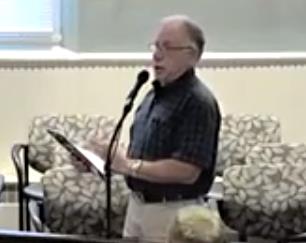
“You need not consider (tonight) whether, when, or where to build a Center of Government,” I said. “Nor do you need to decide office relocation. You need only to decide whether the Former Baker Dental Building holds sufficient potential within your future relocation options for it to remain standing and as a part of Tompkins County’s building inventory. I believe it does and should.”
“You may later regret you threw this building away,” I closed.
But before Tuesday’s meeting ended, Greg Mezey, new to the Legislature this year, and though a supporter of the Baker Building’s prompt deconstruction, took a larger view to the County’s options. He questioned whether a Center of Government might be built outside of downtown, in a place with ample parking and easy highway access, something akin to the “adaptive re-use” Cayuga Medical Center will make of the Shops at Ithaca Mall.
Mike Lane, an avid supporter of keeping offices downtown, had a ready response.
“I think the conversation you’re really talking about, Greg, is what we used to refer to as putting a new building out in a cornfield somewhere.”
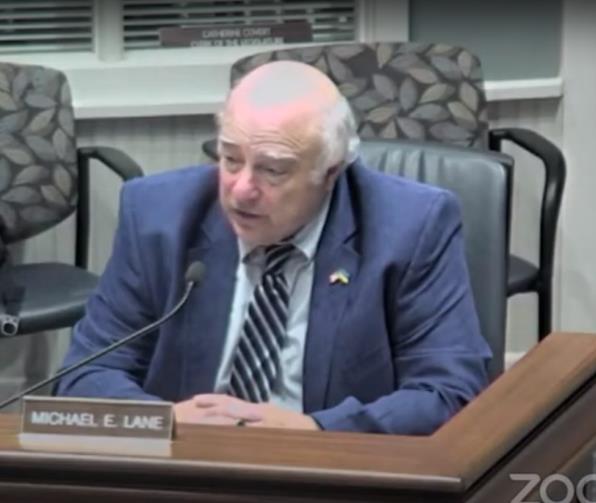
Doing that, Lane said, would defy recent practice. Since the County moved Social Services from its old hospital site to downtown decades ago. “I can’t think,” said Lane, “where we’ve ever really considered building out in the rural areas. Ithaca is our county seat.”
“We now have three-and-a-half million dollars’ worth of property,” Legislature Chair Shawna Black remarked, Black perhaps lowballing the cost of recent purchases. “We’ve invested a lot of time” and “quite a lot of money,” toward consolidating offices downtown.
Nonetheless, Black conceded “that’s not to say we’re pigeonholed into a decision.” And given rising construction costs, the Chair acknowledged, “At this point it seems like we’re kind of into a holding pattern anyway.”
###
Tompkins Abortion Sanctuary Bill Passes
Legislature supports Starbucks Workers; sends Redistricting plan back
by Robert Lynch, August 2, 2022; additional reporting, Aug. 3, 2022
By a straight party-line vote, the Tompkins County Legislature Tuesday, without using the precise word, declared its county a sanctuary for abortion rights.

Approval of the pro-abortion rights Resolution, advanced by the Legislature’s five women members, all Democrats, came at a four-hour meeting where members also backed a toned-down measure asking the National Labor Relations Board to investigate the closing of Starbucks Collegetown coffee shop as a possible anti-union tactic and directed a controversial 16-member legislative redistricting plan to go back to the commission that prepared it for possible—albeit, unlikely—revision.
Additionally, legislators tabled for two months a committee-backed proposal to deconstruct the “Former Baker Dental Building,” a half-century old brick and block structure on the 400 Block of North Tioga Street that the County bought in 2019 intending to put a new office building there before it changed its plans.
The abortion rights Resolution, the most controversial of the night, though brought to a vote in only ten minutes’ time, directed that County Departments, officers, employees and agents “shall not abridge or interfere in any way with any person’s right to access legal surgical or medication abortion services.” What’s more, under its language, no County employee shall cooperate with any out-of-state request for information about those who travel to Tompkins County to seek abortion services.
Lansing legislator Deborah Dawson, who claimed authorship of the abortion rights resolution, and called it “a labor of love,” said she viewed the measure as a safeguard against a potential conservative turn in New York State politics, one in which a Republican State Legislature and Governor might change the laws to restrict abortions in the Empire State.
Among its provisions, the adopted measure would back a pending amendment to the New York State Constitution that would “recognize and enshrine every person’s bodily autonomy and reproductive rights” as well as other rights of due process and equal protection.
While all three of the County Legislature’s Republicans opposed the abortion rights resolution, they each kept their comments low-key. Lansing’s Mike Sigler, an expected critic, waived off comment. Groton’s Lee Shurtleff observed the New York amendment the resolution supports “broadens the Constitution quite a bit.”
On the Starbucks matter, whereas the Legislature in late-June had roundly rejected member Veronica Pillar’s prior attempt to condemn the coffee giant for its “virulent and brutal anti-union attacks” by its alleged retaliatory closing of its College Avenue eatery, members voted ten-to-four Tuesday—an exact reversal—for Pillar’s much more moderated replacement.
The resolution lawmakers adopted Tuesday, further watered down by a floor amendment just prior to the vote, urged the National Labor Relations Board to investigate Starbucks closure of the College Avenue location “as an illegal anti-union tactic meant to retaliate against and unlawfully fire Starbucks employees” for unionizing.
The Legislature also urged the NLRB to “investigate the College Avenue Store closure.” Stripped from the wording at the last minute was Pillar’s request that would have demanded Starbucks rescind its closure.
****
Abortion Rights: The County Legislature’s support of abortion protections, coming on the same night that Kansas voters rejected an effort to roll back abortion protections in their state, mirrored an earlier, though separately-worded, affirmation of reproductive freedoms adopted unanimously by Ithaca’s Common Council July 6th.

Only Groton’s Lee Shurtleff took much effort Tuesday to confront the language of Dawson’s long-winded, three-page Resolution, a draft containing as many as 25 separate paragraphs of justification. Shurtleff focused only on paragraph number 25. The line affirmed that the Legislature “recognizes that every individual’s right to personal reproductive autonomy is central to their human dignity and liberty to determine their own life course.”
“Is that without limitation or restriction?” Shurtleff asked.
“No,” Dawson answered. “I’m not supporting third-trimester abortion…. I think the ship has sailed on really extreme (procedures, such as) you can have an abortion on demand anytime you want to.”
“But on the other hand,” Dawson continued, “you shouldn’t be forced to risk your life to bring a pregnancy to term; you shouldn’t be forced to take a pregnancy to term when the fetus is dead; and you shouldn’t be afraid to miscarry on pain of being prosecuted for murder or violating an abortion ban.”
And in answer to Shurtleff’s concern about the breadth of the state constitutional change her resolution supports, Dawson pointed to Justice Clarence Thomas’ controversial concurrence in the recent “Dobbs” decision that overruled Roe v. Wade. In that concurrence, Justice Thomas had written that constitutional consistency may dictate the Dobbs reasoning extend to limit rights to same-sex marriage or contraception.
“So there is a broad spectrum of rights,” Dawson argued, “which are now up for grabs.”
Starbucks: Like the abortion rights resolution, Tuesday’s retooled Starbucks measure followed on the heels of an earlier Ithaca Common Council affirmation of worker support.

The County Legislature’s sponsor, Ithaca’s Veronica Pillar, acknowledged her revision was “softer than last time.” Yet, Pillar argued, “I really think it’s incumbent upon us as leaders in this County (to stand up) for the values we’ve affirmed.”
“We support our residents who work here and are struggling for basic human rights,” Pillar continued, “and it’s not OK for a corporation to come in and walk all over us.”
On this measure, however, Republican Sigler had an answer…. sort of.
As the Lansing Republican pieced together the facts, a clogged grease trap at the Collegetown store had prompted worker unionization and a strike. Those actions, in turn, may have prompted Starbucks’ closing. Sigler noted that actually the Fire Department handles clogged grease traps and that the Health Department has had no complaints.
“I’m going to take care of hopefully the things that I can take care of,” Sigler said.
Left in Pillar’s Resolution were words stating that the Legislature “condemns without reservation Starbucks pattern of anti-union practices against its workers,” and it requested the Ithaca store’s closure be folded into a nationwide cease and desist order against Starbucks.
Joining Sigler in his opposition to the measure were fellow Republican Lee Shurtleff and Democrats Rich John and Mike Lane.
Redistricting: Breaking an impasse of sorts that arose two weeks earlier, the Legislature advanced to an August 16th Public Hearing a committee-endorsed plan of the Tompkins County Independent Redistricting Commission that would expand the Legislature’s size from 14 to 16 members beginning in 2026. But the Legislature also narrowly granted legislator Lane’s request to return the redistricting plan to the Commission for a second look.
The conflicting parallel tracks would place before the mid-month hearing a redistricting plan that, if revised by the Commission, would require yet a second public hearing later. Nonetheless, as many suspect, the Commission could simply reaffirm its original 16-member plan, a move which under the County Charter, lawmakers would find themselves hard-pressed to overrule.
“I don’t see any value in adding legislators,” Newfield-Enfield’s Randy Brown commented in support of sending the redistricting plan back. “We only have two meetings a month. We don’t want to create any more committees. So what would these people do?”
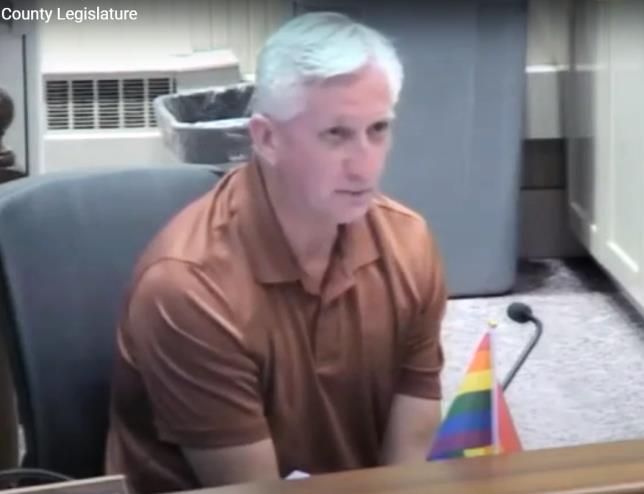
“I think this is a waste of our time; I think this is a waste of the Redistricting Commission’s time,” Dryden’s Greg Mezey countered. “The ship has sailed here, and that’s where we should leave it.” (Note it was the second time that night that a legislator had used the nautical metaphor.)
But Ithaca West End rep Travis Brooks has his own complaint he wants the Independent Commission to explore. In marrying Tompkins County districts with Ithaca City wards, the Commission, Brooks argued, severed his minority-heavy Northside and Southside neighborhoods.
“You’ve cut out the heart of the Northside and moved it to Fall Creek,” Brooks complained.
Mike Lane’s concern about the Commission’s plan has always been about the Legislature’s size and a 16-member body’s inability to break a tie. His effort to remand the 16-member plan back to the Commission directed it consider setting a total membership at 15 legislators or fewer and making it an odd number. The Commission holds no legal obligation to honor Lane’s request.
Seldom during the past decade—but most notably during the long chairmanship battle of 2020—has the Legislature deadlocked with a 7-7 tie vote. But ironically, it came close to doing so on Lane’s own resolution.
Chair Shawna Black was on the fence. Her ending comment saw value in the Commission’s revisiting Brooks’ concerns but noted little need to cut legislative size. Black’s provided the decisive eighth vote for reconsideration. Had she dissented, the vote would have tied—proving Lane’s own point, but giving him little comfort .
###

